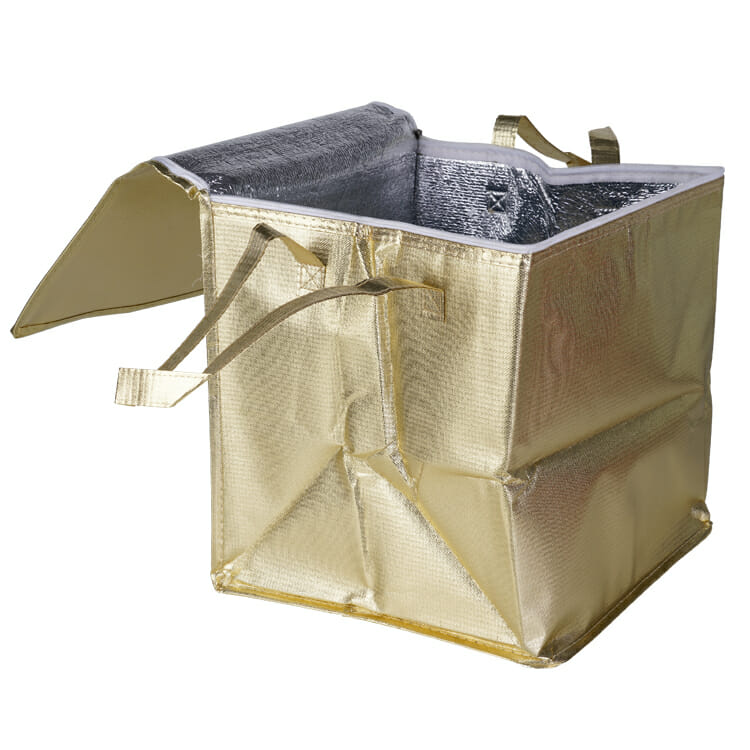According to experts, perishable food items frequently found in a lunch bag such as meats, cheese, prepared dishes, milk, and yogurts should always be kept at or below 40 degrees Fahrenheit. This is extremely difficult to achieve using a plastic or metal lunch box, as neither provides adequate insulation.
Unless you can put your lunch in the refrigerator as soon as you arrive at school or work, your food will be warmer than 40 degrees by the time your lunch break arrives. Even worse are brown paper or plastic bags. However, when you pack your lunch in an insulated bag, you can enjoy fresh meals.
What Is the Function of Insulated Lunch Bags?
The majority of insulated lunch bags have multiple layers of insulation. They normally have an exterior layer, a lining, and an insulation layer in the middle. The center layer is the most significant since a lunch bag would be no better than a regular lunch box without it.
Insulated lunch boxes rely on a vacuum produced between the outer and inner layers to prevent energy loss. They also have a solid foam core layer to keep food and drinks warm or cold. The better the insulation, the thicker and denser the foam.
Since the heat is kept from dissipating in the environment, the exterior of insulated lunch bags does not heat up when loaded with heated items. The foam layer stops heat from seeping through to the outer layer, preventing cold or heat from reaching the bag’s contents.
Many insulated lunch bags include a waterproof and heat-reflective inner layer or lining made of foil, thick vinyl, or plastic as an added layer of protection. The bag’s foil-like inner layer reflects the thermal energy from the metal rather than absorbing it and allowing it to escape the bag.
As a result, the food within lasts longer than in a conventional bag, retaining its original temperature, flavor, and moisture. Like tin foil, an insulated lunch bag will keep food from growing stale, but to a far greater level.
This is why insulated lunch bags are essential for people who like to pack their lunch on the move. It is also ideal for kids who take homemade lunch to school. So if you would rather have a healthy homecooked meal than risk your health, you need an insulated lunch bag.
How to Remove Insulated Lunch Bag Smells
Any container that keeps food for long periods will develop an odor over time. Lunch bags are no different. Here are a few ways to prevent insulated lunch bag smells. You’ll require the following;
- Bleach
- Soda bicarbonate
- Water
- Sponges or soft cloths
- Bottle for spraying
- Towels
How to Get Odors Out of Lunch Bags
- Fill a spray bottle halfway with water and a mild bleach solution.
- Apply the bleach solution to the inside of the lunch bag.
- With a gentle cloth, wipe thoroughly until it is dry.
- Allow it to air dry.
- Make a paste from water and baking soda.
- Using a soft cloth, apply the paste to the internal surfaces of the lunch bag.
- Allow for thorough drying of the paste.
- Wipe away with a soft cloth or use a towel to remove the dried paste.
- Sprinkle dry baking soda in the lunch bag and set it aside overnight. The baking soda will absorb the scents, which may be shaken off in the morning.
Improving the Performance of Insulated Lunch Bags
To keep your meals cold or warm with an insulated lunch bag, here are some suggestions:
- Include a warm or cold pack to keep your food fresh. You can use a heated water bottle or gel pack to keep the food warm and a cold gel pack or juice box to keep the food cold.
- Before packing, reheat the meal, or pack refrigerated food straight from the fridge or freezer into the lunch bag.
- Wrap the food in aluminum foil for added insulation
- Don’t open it until you’re ready to eat the meal to prevent thermal energy from escaping the lunch bag.
- Keep the lunch sack in air-conditioned areas
- Choose the correct size lunch bag for your needs; a partially filled insulated container is less effective than a full one.
- Separate hot and cold items, even if some are within the bag and others are outside.
How Long Will My Food Stay Warm or Cold in an Insulated Lunch Bag?
This is a difficult question to answer. The amount of time food can be stored in an insulated lunch bag depends on several factors:
- Bag design
- Whether the insulated bag contains a hot or frozen gel pack
- Outside temperature.
Hot meals can remain warm for about three hours while cold meals can stay cold for up to five hours without adding gel packs. Three to four hours can be gained using a hot or chilled gel pack.
However, these figures highly depend on the bag’s quality and the ambient temperature. So, before taking your insulated bag out for lunch, make sure to test it at home.
Advantages of Using an Insulated Lunch Bag
It is Practical
It will keep your food safe and secure because of its multiple insulation layers. Most insulated lunch bags are small enough to carry around and have handles or straps for folks on the go.
Keeps your Meal at the Right Temperature
The most prevalent issue is keeping food at the proper temperature. You may hear customers express concern about their packed meals becoming cold and hard when ready to eat them. Microwaves and refrigerators are not available in every business or school. An insulated lunch bag can come in handy. It keeps your meals hot or cold and fresh for the entire day.
It is Environmentally Friendly
These lunch packs can be used again. There’s no need to keep buying plastic wrap, paper bags, and other containers because you may use them every day. Other high-quality insulated lunch bags can last for years.
You can shop for a variety of insulated bags from us. As wholesale manufacturers, we can accommodate large quantity orders and ship worldwide. Please fill out the contact form for more information.


